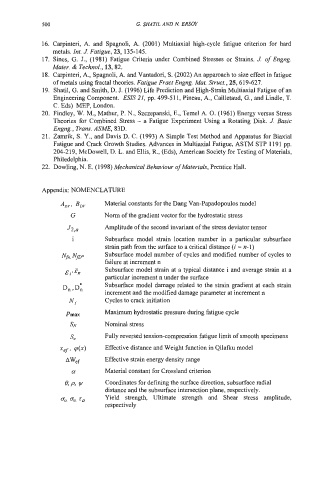Page 516 - Biaxial Multiaxial Fatigue and Fracture
P. 516
500 G. SHATIL AND N. ERSOY
16. Carpinteri, A. and Spagnoli, A. (2001) Multiaxial high-cycle fatigue criterion for hard
metals. Int. J. Fatigue, 23, 135-145.
17. Sines, G. J., (1981) Fatigue Criteria under Combined Stresses or Strains. J. of Engng.
Mater. & Technol., 13,82.
18. Carpinteri, A., Spagnoli, A. and Vantadori, S. (2002) An apparoach to size effect in fatigue
of metals using fractal theories. Fatigue Fract Engng. Mat. Struct., 2561 9-627.
19. Shatil, G. and Smith, D. J. (1996) Life Prediction and High-Strain Multiaxial Fatigue of an
Engineering Component. ESIS 21, pp. 499-51 1, Pineau, A., Cailletaud, G., and Lindle, T.
C. Eds) MEP, London.
20. Findley, W. M., Mathur, P. N., Szczepanski, E., Temel A. 0. (1961) Energy versus Stress
Theories for Combined Stress - a Fatigue Experiment Using a Rotating Disk. J: Basic
Engng., Trans. ASME, 83D.
21. Zamrik, S. Y., and Davis D. C. (1993) A Simple Test Method and Apparatus for Biaxial
Fatigue and Crack Growth Studies. Advances in Multiaxial Fatigue, ASTM STP 1191 pp.
204-219, McDowell, D. L. and Ellis, R., (Eds), American Society for Testing of Materials,
Philedelphia.
22. Dowling, N. E. (1998) Mechanical Behaviour of Materials, Prentice Hall.
Appendix: NOMENCLATURE
Material constants for the Dang Van-Papadopoulos model
Norm of the gradient vector for the hydrostatic stress
Amplitude of the second invariant of the stress deviator tensor
Subsurface model strain location number in a particular subsurface
strain path from the surface to a critical distance (i = n-I)
Subsurface model number of cycles and modified number of cycles to
failure at increment n
Subsurface model strain at a typical distance i and average strain at a
particular increment n under the surface
Subsurface model damage related to the strain gradient at each strain
increment and the modified damage parameter at increment n
Cycles to crack initiation
Maximum hydrostatic pressure during fatigue cycle
Nominal stress
Fully reversed tension-compression fatigue limit of smooth specimens
Effective distance and Weight function in Qilafku model
Effective strain energy density range
Material constant for Crossland criterion
Coordinates for defining the surface direction, subsurface radial
distance and the subsurface intersection plane, respectively.
Yield strength, Ultimate strength and Shear stress amplitude,
respectively

